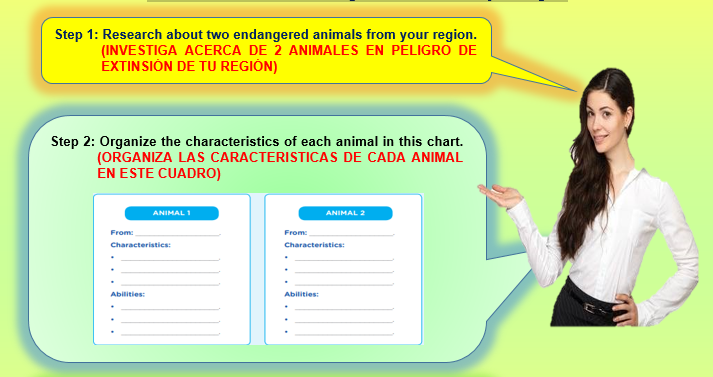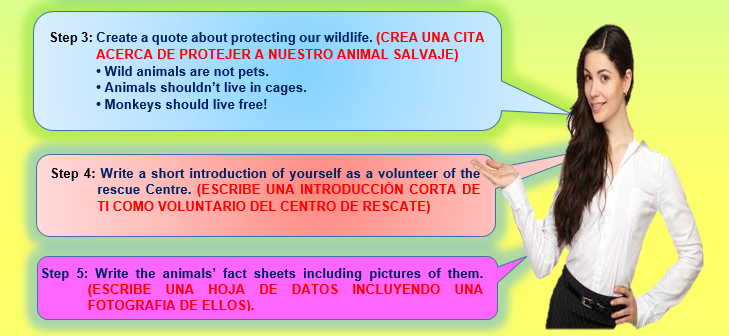READ the article about the
wildlife rescue centre in Ucayali:

LET’S UNDERSTAND:
Circle TRUE, FALSE or DOESN’T SAY. Follow the example:

1. The Ucayali Wildlife Rescue Centre has animals from different
regions from Peru.
a) TRUE b) FALSE c) DOESN’T SAY
2. Spider monkeys use their arms and legs to get their food.
a) TRUE b) FALSE c) DOESN’T SAY
LISTENING
COMPREHENSION
LISTEN to a conversation about
animals in the Highland Wildlife Sanctuary. Complete the fact sheets of the
animals. You will hear the conversation twice. Number one is the example:

LET’S CREATE!
Let’s help endangered animals!
Teenagers do different activities in their free time. You have
decided to be a volunteer in a wild animal rescue Centre. One of your duties in
the Centre is to create the animals’ fact sheets, in order to describe their
characteristics and abilities, so that, visitors from all parts of Peru and the
world can know more about them. Choose one of the options:
Fact sheets about two endangered animals from your region


Puedes
seguir esta estructura como ejemplo:
• Title
· Introduction
of yourself as a volunteer.
•
Introduction of the rescue Centre.
•At least
three sentences describing the first animal’s characteristics and abilities.
•At least three sentences describing the second animal’s characteristics and abilities.
• Quote about protecting wildlife.
Your text should include the following characteristics:
|
INICIO
(0 – 10) |
PROCESO
(11 – 14) |
LOGROESPERADO
(15 – 17) |
LOGRO
DESTACADO (18 – 20) |
|
No tiene título, y no empieza con una introducción como voluntario a
un centro de recate de vida salvaje. |
Tiene título, y no empieza con una introducción como voluntario a un
centro de recate de vida salvaje. |
Tiene título, y empieza con una introducción como no voluntario a un
centro de recate de vida salvaje. |
Tiene título, y empieza con una introducción como voluntario a un
centro de recate de vida salvaje. |
|
No incluye oraciones q describan las características físicas de cada
animal usando correctamente el HAS y HAVE. |
Incluye al menos 1 oración que describa las características físicas de
cada animal usando correctamente el HAS y HAVE. |
Incluye al menos 2 oraciones que describan las características físicas
de cada animal usando correctamente el HAS y HAVE. |
Incluye al menos 3 oraciones que describan las características físicas
de cada animal usando correctamente el HAS y HAVE. |
|
Incluye al menos 1 oración que describa que puede o casi bien no puede
hacer un animal. |
Incluye al menos 1 oración que describa correctamente que puede o no
puede hacer un animal. |
Incluye al menos 2 oraciones que describan correctamente que puede o
no puede hacer un animal. |
Incluye al menos 3 oraciones que describan correctamente que puede o
no puede hacer un animal. |
|
En tu creación la cita final NO incluye sobre la protección de nuestra
vida salvaje. |
En tu creación la cita final incluye poca información sobre la
protección de nuestra vida salvaje. |
En tu creación la cita final casi incluye información sobre la
protección de nuestra vida salvaje. |
En tu creación la cita final incluye sobre la protección de nuestra
vida salvaje. |
|
No incluye fotografías relacionados con el relato. |
Incluye fotografías que no se relacionan con el relato. |
Incluye 1 sola fotografía relacionados con el relato. |
Incluye fotografías relacionados con el relato. |

|
|
Can
I do it? |
Not
at all |
Somewhat |
Well |
Very
Well |
|
01 |
Can I identify key details in a text
about animals’ characteristics and abilities in English? |
|
|
|
|
|
02 |
Can I describe animals’
characteristics using appropriate adjectives and the verbs “have” and “has”
in English correctly in a simple text? |
|
|
|
|
|
03 |
Can I describe animals’ abilities
using appropriate verbs of actions and “can” and “can’t” correctly in English
in a simple text? |
|
|
|
|
https://www.youtube.com/watch?v=vtllMWJXQrY
https://www.youtube.com/watch?v=d2Q1Si585T4







No hay comentarios:
Publicar un comentario